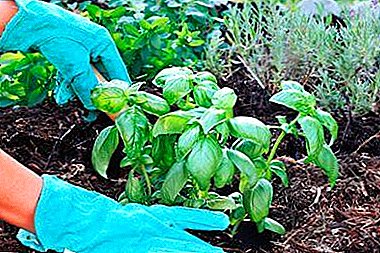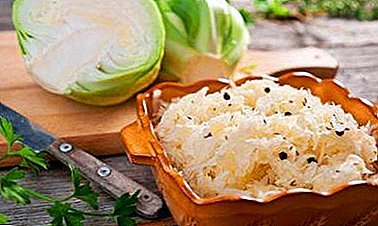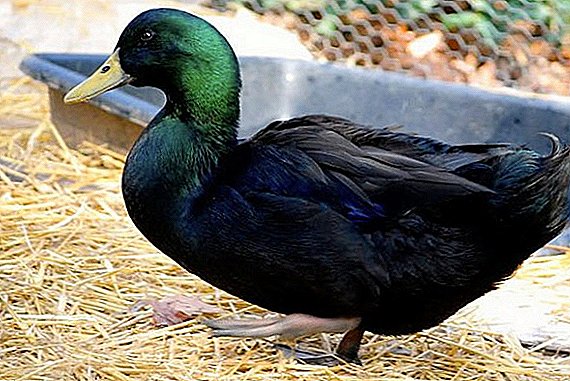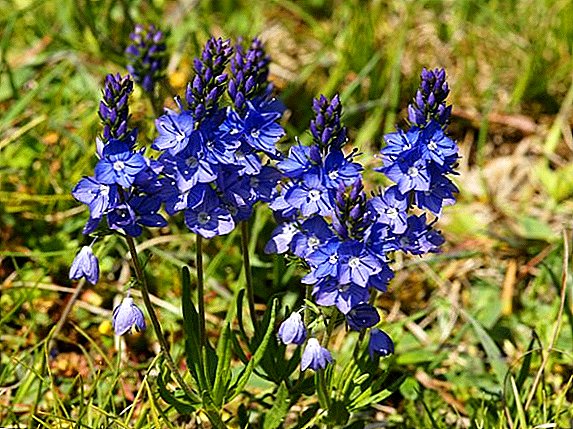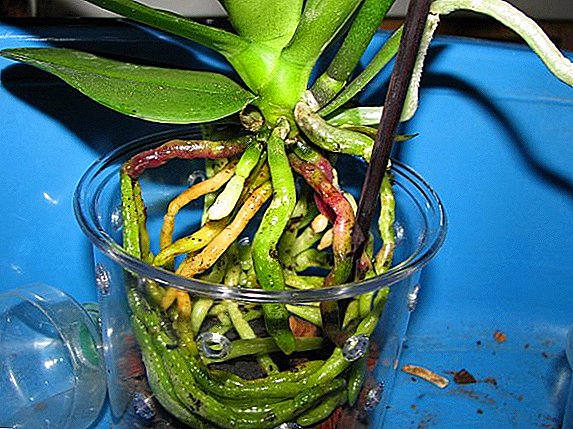 Orchid healthy roots have a greenish tint, elasticity and density. The aerial part of the flower signals problems with the root system - the turgor of the leaves is lost, growth stops. It is noticeable that the part of the root system, which is outside the substrate, changes its color, becomes soft and wet, or, on the contrary, dries out. Do not rush to get rid of such an instance - the plant can still be tried to reanimate. We learn about the causes of loss of the roots and how to build a new orchid root system.
Orchid healthy roots have a greenish tint, elasticity and density. The aerial part of the flower signals problems with the root system - the turgor of the leaves is lost, growth stops. It is noticeable that the part of the root system, which is outside the substrate, changes its color, becomes soft and wet, or, on the contrary, dries out. Do not rush to get rid of such an instance - the plant can still be tried to reanimate. We learn about the causes of loss of the roots and how to build a new orchid root system.
Causes of root loss?
Usually improper care or the presence of insect pests leads to the death of the orchid root system. Consider the most common causes of root death.
Irrigation Disruption
One of the most common causes of root decay is the excessive moistening of the substrate in which this beautiful flower grows. This condition is especially dangerous in the cold period when temperatures drop and there is a lack of sunlight. At this time, the plant needs more rare watering than in warm weather. Between watering should always give the substrate to dry.
Important! You should not get too carried away with fertilizers or increase the recommended concentrations, use funds not for orchids. An excess of minerals can cause the death of sensitive orchid roots.
Against the background of high humidity develop diseases that cause the death of the roots. At the same time, one should not too often skip watering or make them too scarce; forget to spray the plant, especially in the summer heat. Such a situation may cause the drying of the root system and the flower.
Non-observance of temperature
Hypothermia can kill a tropical flower. Typically, thermophilic orchids freeze over for half an hour when temperatures drop to + 10 ... + 15 ° С. This should be considered if the plant is located on a cold window or on a balcony, when transported from the store. Cold-resistant species are affected at temperatures of -2 ... + 2 ° C.

We can not allow complete frostbite of the plant, because in this case it can not be saved. Avoid drafts and extreme temperature changes when ventilated during frosts. Too high temperatures and exposure to direct sunlight in the summer heat can cause the root system to dry out. At this time, the flower should be pritenyat from hot rays, often watered and sprayed.
Pests
Orchids can be attacked by pests affecting the root system:
- Nematodes. These are tiny worms that breed in warmth and dampness. They live in the soil and in all parts of the plant. Leaf nematodes manifest themselves brown and black spots on the foliage. The activity of the root nematode leads to the formation of gall (blistering) roots and their death. Nematodes die at temperatures above + 45 ... + 50 ° C. The advanced flower growers are in no hurry to dispose of the plant, and once every 2 weeks they give him a shower, gradually bringing the degree of water to + 50 ° C. The plant also needs to be transplanted, disinfected with soil and container with boiling water, cut off the damaged roots and grow new ones.
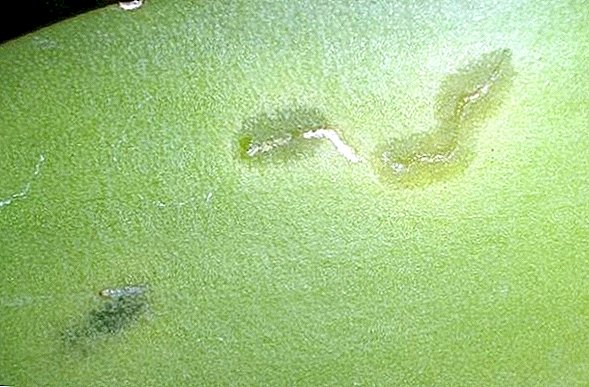
- Mealybug. It refers to small insects sucking sap (0.5-12 mm), the presence of which produces white vatoobrazny raid. They love to lay eggs in unobtrusive places - in the axils of leaves, buds, on the roots. They love warm, dry air and nitrogen-fed specimens. The pest is mechanically removed with a cotton swab dipped in soapy water. Be sure to make a transplant with a revision of the root system. With minor lesions, you can use the infusion of garlic. For severe lesions, they use "Mospilan", "Aktellik", "Aktara" with repeated treatment in a decade.

- Ticks. Some species affecting the base of the stem and the root system are not readily visible. It is difficult to get rid of ticks affecting the root system. It is better to find a non-residential premises and use in it a tool from the carbamate group "Marshal", which will solve this problem radically. With spider mites, it is sufficient to conduct a couple of treatments with chemicals such as "Aktelik" and "Fitoverm".
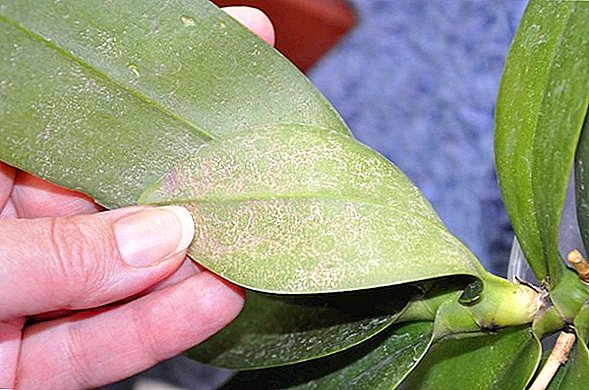
- Mokritsy. Appear on specimens that were carried out to fresh air. Live in the substrate. It is easy to get rid of them by immersing a pot with a flower in water or with the help of pyrethrum preparations.
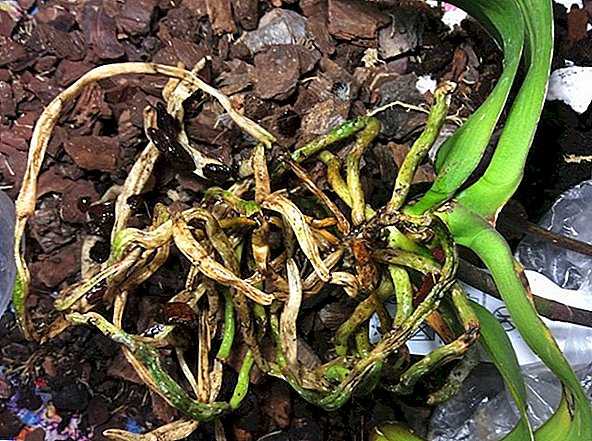
Important! Be sure to arrange a quarantine purchase orchid and check the presence of insects in the substrate by dipping. Do a careful inspection of the selected instance still in the store.
Preparing the root growing environment
Having found out the cause of the death of the root system, it is necessary to prepare to remove the affected and dead roots and begin to build new ones.
For this you need to stock the following:
- crushed charcoal (can, activated carbon from the pharmacy) or cinnamon powder;
- sharp alcohol-disinfected knife;
- the desired fungicide or insecticide (if it detects a disease or pests).
Then it is necessary to make a recess of the orchid from the tank, carefully release the roots from the substrate, rinse with warm water, and carefully examine them and the plant itself. Remove the diseased parts, and sprinkle the cut areas with coal or cinnamon. Then let dry for 6 hours.

If nematodes are found, the flower should be completely immersed in water heated to + 45 ... + 55 ° С. Depending on the degree of damage, keep it there for 5-30 minutes, maintaining the required temperature. When a mealybug is detected, the plant must still thoroughly wash the remaining roots and remove the pest manually.
When diseases are found, it is required to use the fungicides corresponding to them, but it is necessary to maintain a weakened flower in the chosen remedy for no more than 10-15 minutes. Then let the orchid dry for 12-24 hours.
Important! When identifying pests and diseases, it is necessary to inspect the neighboring plants and do the processing of the orchid growing area and capacity.
The main methods of growing roots
There are several techniques that will help the orchid grow roots. They can be used both for the injured plant, whose roots have died, and for the children of the orchid.
Using water
Mainly rooting orchids occurs with the help of water.
Always in the water
This method is not always used. It can provoke repeated rotting of the root system.
The rooting process itself in this case occurs as follows:
- Warm soft water is poured into the container. The use of rooting stimulants is possible.
- The plant is placed so that the base with small roots are always under water. Usually the end is immersed in water for 1 cm.
- As the evaporation of moisture flower is lowered below.
- Once every 7 days the water is changed completely.
Video: Resuscitate the orchid in the water
Above the water
Growing roots above the surface of the water is considered the most trouble-free way.
It is carried out as follows:
- Pour some water into a transparent container. She must have such parameters so that the plant does not fall into it. Alternatively, you can use a 5-liter plastic bottle and fix the plant with wire.
- The orchid is placed in a container so that it does not reach 1-2 cm of water. Then the bottle is capped on top.
- Every day, the flower is removed and placed for 1 hour in a solution with sugar or glucose. Then it is dried a little and placed again in the container.
- After 1 day in the evening, the plant is placed in a solution of vitamins. It is necessary to do it in the evening so that the vitamins do not fall apart due to direct sunlight.
Did you know? Some flower growers keep the orchid in the water not all day, but only 6 hours. The rest of the time the plant is dry. With this method, the plant subsequently easier to take root in the substrate.
Up roots
This method of increasing the root system of an orchid gives a high result. The roots remain open, but are protected from excess moisture and decay.
The procedure for this method is as follows:
- The foliage is carefully picked and the plant is placed in a plastic bottle with the tip down.
- Pour warm water with stirred activated carbon powder to the middle of the sheet.
- The base, which is left in the air, is sprayed daily with a spray bottle.
- When shoots appear, the orchid is turned over and placed in moss soil for the subsequent formation of the root system.
- When the roots are sufficiently grown, transplant the flower into a permanent substrate.
In the substrate
This method is well suited to instances that have retained some of their root system. The advantage of such rooting is that when it is no longer necessary to adapt to new conditions. Plant transplantation together with the substrate will not be a great stress for the orchid. Sphagnum or vermokulite is commonly used as a substrate.

The sequence of actions for this method is as follows:
- At the bottom of the pot place a layer of drainage of expanded clay or small pebbles.
- A sphagnum is laid on top, slightly tamping it.
- The plant is located in such a way that the base is not completely closed and the root collar is loose.
- The flower is fixed to the supports installed in the substrate.
- The top layer of sphagnum is moistened by spraying from a spray bottle.
Did you know? The orchid ofis, which grows in Russia on the Caucasian Black Sea coast, emit the smell of bees to attract pollinators. The shape and color of the middle of the flower also resemble bee females.
On the bark
You can root an orchid on a fairly large piece of bark from the forest. This method is rarely used, but if you want you can choose it.
The process of rooting with the bark is as follows:
- First you need to disinfect the bark. To do this, boil it for an hour and allow it to cool. Purchased bark is soaked in water to saturate with moisture.
- Stripes are cut out of nylon tights with scissors. They fix the plant to the supports installed in the tank. These are usually thin wooden or plastic sticks. The base of the orchid must necessarily touch the wet bark.
- The root neck is treated with a stimulant or a solution of vitamin B1.

After a few weeks, the rooting process should begin, and after 3 months the root system should already be formed. The roots of the plant eventually grow on the surface of the bark. To carry out watering and spraying shoots is not worth it. It is worth noting that dryness in the room when choosing this method is unacceptable. Therefore, it is necessary to place containers with water near the bark with a flower. If the bark is still dry, then it will need to moisten.
Care during the extension of orchid roots
During the period of growing roots, orchids should provide the best care. Rooting will be successful in the optimal temperature range of + 23 ... + 25 ° C and with good but diffused illumination. The direct rays of the sun should be excluded. Therefore, place the flower only on the windows facing east or southeast. In the cold period, a pot with a flower should be placed on the south or south-west side, it is possible to illuminate the fitolamp. The optimal day length is 12 hours. It is necessary to ensure that there are no drafts and temperature drops.
Also read whether it is possible to reanimate an orchid if the roots have rotted.
It is not necessary to feed in such a period, but when the first roots appear, you can improve this process with the help of stimulants. Do not worry if one of the leaves (bottom) began to turn yellow and dry - this flower takes nutrition from it to form roots.
It will be good to feed the flower with group B vitamins. The solution for dressing is prepared as follows: ½ cup of water should be taken with 1-2 drops of vitamin B6, B12, B3. This solution should wipe the leaves and process the base of the plant. It is possible to strengthen the plant against various diseases in the rooting period with the help of Fitosporin. This is especially true for plants on which signs of disease were observed.

Preparations to accelerate the process of building roots
To the roots of the orchid were formed quickly, you can use tools such as:
- Succinic acid. It is used in the form of a solution. One tablet is enough for 1 l of liquid. This solution is used for spraying, wiping leaves or watering no more than 1 time in 30 days.
- Vermiculite It is used instead of moss or bark. Unlike these components, vermiculite contains many useful elements. The drug "Kornevin". Excellent stimulates the process of increasing the root system. The plant is placed in the solution "Kornevina" for 15-20 minutes before further rooting. Sometimes heteroauxin is used instead, sugar, honey or aloe juice is dissolved in water.
- The drug "Fitosporin". Helps to restore the orchid after the discovery of any fungal diseases. In a solution of such a preparation, the plant is soaked for 20 minutes, and after it is planted or further rooting.
- Glucose. A solution containing glucose, wipe the leaves and place the plant itself on the radical neck. The solution can be made independently by mixing 1 ampoule with 1 liter of liquid.
- "Appin" or "Zircon". These are biostimulants of growth that will help to survive the orchid during unfavorable time for it.
Did you know? In 2000, revenue from sales of orchids in the United States reached $ 100,000,000. Almost 75% of all sales made phalaenopsis.
You can not place the flower in these solutions so that water can get into the base between the leaves.
The main mistakes when building roots
Due to lack of experience, beginning flower growers often make the following mistakes:
- Cuts are not processed, and pathogens can penetrate through them.
- Do the processing of sections of plants with brilliant green or means containing alcohol, which leads to their drying.
- Do not provide a wealth of lighting, and the flower can go into hibernation mode.
- In summer heat they forget to protect the flower from the direct rays of the sun, which cause a burn.
- Waterlogging that causes the appearance of root rot.
- Carry out the removal of drying leaves. Such actions can lead to the death of an orchid, because of them the plant takes its nourishment for growth and development.
Did you know? Orchid got its name from the ancient Greek word meaning "egg". So the flower was called because of the shape of the tubers.Having noticed signs of problems with the root system, you should carefully examine the plant for the presence of pests and analyze the growing and maintenance conditions. Then you should proceed to the resuscitation of the plant by building new roots.







